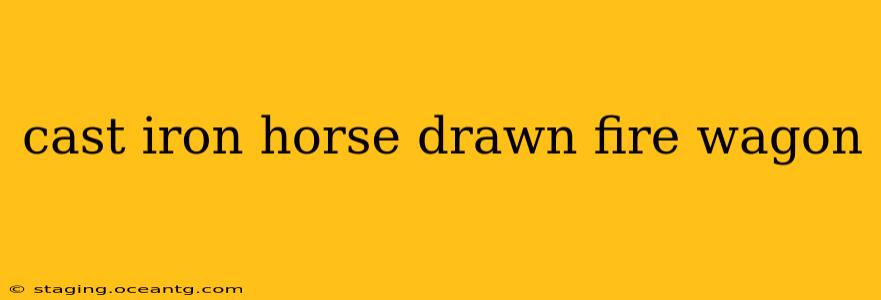The image of a horse-drawn fire wagon, its gleaming cast iron components reflecting the flickering flames, conjures a romanticized vision of firefighting's past. These magnificent pieces of history represent not just a bygone era of firefighting, but also a testament to the ingenuity and craftsmanship of the time. This article delves into the fascinating world of cast iron horse-drawn fire wagons, exploring their construction, functionality, and enduring legacy.
What Made Cast Iron Ideal for Fire Wagons?
Cast iron's properties made it uniquely suitable for the demanding role of a fire wagon. Its high compressive strength allowed for the creation of robust and durable structures capable of withstanding the jarring movements and heavy loads associated with transporting equipment and personnel to fire scenes. Further, cast iron was relatively inexpensive and readily available during the periods when these wagons were most common. Its ability to retain intricate details allowed for the creation of ornate designs, transforming functional vehicles into impressive works of art.
How Were Cast Iron Fire Wagons Constructed?
The construction of a cast iron horse-drawn fire wagon was a complex process, involving skilled artisans and foundries. The process typically involved:
- Pattern Making: Creating wooden patterns to shape the molten iron. This was a crucial step, demanding precision and expertise.
- Melting and Pouring: Molten iron was poured into the sand molds created from the patterns.
- Cooling and Finishing: Once cooled, the cast iron components were carefully removed, inspected, and finished to ensure strength and functionality.
- Assembly: The various cast iron components—wheels, chassis, ladders, and other equipment holders—were meticulously assembled, often bolted or riveted together.
The finished product was a testament to skilled craftsmanship, capable of carrying significant weight and navigating challenging terrain.
What Equipment Did Cast Iron Fire Wagons Carry?
The equipment carried varied depending on the size and resources of the fire department. Common items included:
- Water Tanks: Often integrated into the wagon's design.
- Hand Pumps: Used to pump water from the tank or nearby water sources.
- Ladders: Essential for reaching upper floors of buildings.
- Axes, Hooks, and Other Tools: For breaking down doors, rescuing people, and controlling fires.
- Fire Hose: Although the early hose was made of leather, it was stored and transported on the wagon.
The positioning and securement of this equipment within the wagon's cast iron frame were critical aspects of its design.
What Types of Cast Iron Fire Wagons Existed?
The design of cast iron horse-drawn fire wagons evolved over time, adapting to changing firefighting techniques and technologies. Variations included:
- Chemical Engines: Carried chemicals for extinguishing fires, representing a step towards more advanced fire suppression methods.
- Hose Carts: Specialized wagons solely dedicated to transporting fire hoses.
- Hook and Ladder Wagons: Carried ladders and various firefighting tools, often featuring elaborate designs.
These variations highlight the ongoing innovation and adaptability within the firefighting profession.
Where Can I Find Examples of Cast Iron Fire Wagons Today?
Preserved examples of cast iron horse-drawn fire wagons can be found in various museums and historical societies worldwide. Many are meticulously restored, providing a glimpse into the past and serving as a tribute to the firefighters who used them. These exhibits often include detailed information about the wagons' construction, use, and history.
How Durable Were Cast Iron Fire Wagons?
While incredibly strong in compression, cast iron is brittle and susceptible to cracking under tension or impact. The wagons were robust enough for the demands of their time, but the wear and tear from frequent use, rough terrain, and the inherent stresses of firefighting would eventually lead to damage and necessitate repairs.
Are There Any Reproductions of Cast Iron Fire Wagons?
While full-scale reproductions are rare due to the complexity and cost, some artisans and hobbyists create smaller-scale models or individual cast iron components inspired by historical designs. These smaller pieces offer a way to appreciate the artistry and craftsmanship of the original wagons.
This exploration into the world of cast iron horse-drawn fire wagons reveals a captivating story of innovation, craftsmanship, and the evolution of firefighting. These relics of the past stand as a testament to the dedication and resourcefulness of past generations, reminding us of the crucial role they played in protecting communities.
